Check out these virtual events coming up this month at NCA!
Read MoreIs a manufacturer required to report if a nut-free product was made in a facility that processes nuts?
Read MoreThis memorandum provides a detailed explanation of the expanded geographic preference option. CNP operators, State agencies purchasing for CNPs, and the USDA Department of Defense Fresh Fruit and Vegetable Program (USDA DoD Fresh) may use local as a specification and continue to set a geographic preference when soliciting or buying unprocessed agricultural products.
Read MoreWhere can you find allergens listed on a food’s packaging?
Read MoreCheck out these virtual events coming up this month at NCA!
Read MoreCheck out these virtual events coming up this month at NCA!
Read MoreWe’re thrilled to inform you that the 2024 National Child Nutrition Conference offers an excellent opportunity for you to earn Continuing Professional Education Units (CPEUs) while immersing yourself in a world of learning and networking.
Read MoreThe National CACFP Sponsors Association is excited to introduce the newest group of scholarship winners for the 2024 National Child Nutrition Conference!
Read MoreCheck out these virtual events coming up at NCA!
Read MoreDuring the pandemic, emergency shelters participating in the CACFP were temporarily allowed to claim reimbursement for meals and snacks served to individuals under the age of 25. The Food and Nutrition Service announced that these temporary authorized reimbursements are expected to end on May 11, 2023, concurrent with the expiration of the COVID-19 public health emergency.
Read MoreThe Administration has announced that the plan is for the COVID-19 public health emergency to expire on May 11, 2023. In the event that the emergency ends, on June 10, 2023 nationwide onsite monitoring waivers will expire and onsite monitoring requirements for CACFP will be in effect.
Read MoreThe USDA released a document with proposed revisions to Child Nutrition Programs’ meal patterns in order to be consistent with the 2020 dietary guidelines for Americans. Key proposed changes that affect CACFP include:
1. New “added sugar” standards for breakfast cereals and yogurts
2. Flavored milk restrictions, dependent on age-group
3. Vegetables can be substituted for grains in programs that primarily serve American Indian or Alaska Native children
4. Nuts and seeds may credit for the full meat/meat alternate component
5. Terminology Changes
In December 2022, USDA updated the nondiscrimination statement that all FNS nutrition assistance programs, state or local agencies, and their subrecipients, must post.
Read MoreFood and Nutrition Service released a guidance document on Alternative Protein Products (APP) including Questions and Answers to assist CACFP providers. It is important that CACFP providers understand how to use and properly credit APP in their programs.
Read MoreFood and Nutrition Service amended the regulations of the Summer Food Service Program in September 2022 to strengthen program integrity and streamline program administration. The final rule codifies changes that will simplify the application process, enhance monitoring requirements, clarify existing requirements, and provide more discretion at the state agency level to manage program operations.
Read MoreThe Child and Adult Care Food Program has new creditable foods listed on the USDA Food Buying Guide! If you are new to the FBG, this interactive tool allows for easy display, search, and navigation of food yield information. In addition, users can compare yield information, create a favorite foods list, and access tools, such as the Recipe Analysis Workbook (RAW) and the Product Formulation Statement Workbook.
Read MoreThe Child and Adult Care Food Program community asked for more Spanish resources to be available on the National CACFP Sponsors Association website and we heard you! Available now in Spanish are more resources to help sponsors and providers with meal pattern requirements, best practices, and so much more!
Read MoreServing meals to young people year-round benefits children, families, and care providers. To do this, many providers transition from operating the USDA Child and Adult Care Food Program (CACFP) At-Risk Afterschool (ARAS) during the school year to the Summer Food Service Program (SFSP) while school is out. For an overview of the main differences between SFSP and CACFP ARAS, see the comparison chart below.
Read MoreNCA understands that the end of flexibilities will cause challenges for many CACFP sponsors and providers and we commend your continued commitment to providing nutritious meals and snacks to the children or adults in your care. In preparation for the end of the additional reimbursement, we have collected the following resources to help you successfully provide meals even if your available budget decreases.
Read MoreCDC created three new fact sheets for Early Care and Education (ECE) providers about Early Child Nutrition and Feeding. The fact sheets offer tips and best practices for supporting breastfeeding families, information about safe storage and handling of breastmilk, and strategies for introducing solid foods.
Read MoreIs a manufacturer required to report if a nut-free product was made in a facility that processes nuts?
Read MoreWhere can you find allergens listed on a food’s packaging?
Read MoreWhat are the top nine most common food allergens?
Read MoreWhen serving a meal family style in the CACFP, when are meal counts taken?
Read MoreCan a family style meal be reimbursed if a child does not serve themself all of the food components offered?
Read MoreWhat can you do outside of meal service to prepare children for family style dining?
Read MoreThe Child and Adult Care Food Program has new creditable foods listed on the USDA Food Buying Guide! If you are new to the FBG, this interactive tool allows for easy display, search, and navigation of food yield information. In addition, users can compare yield information, create a favorite foods list, and access tools, such as the Recipe Analysis Workbook (RAW) and the Product Formulation Statement Workbook.
Read MoreThe Child and Adult Care Food Program community asked for more Spanish resources to be available on the National CACFP Sponsors Association website and we heard you! Available now in Spanish are more resources to help sponsors and providers with meal pattern requirements, best practices, and so much more!
Read MoreServing meals to young people year-round benefits children, families, and care providers. To do this, many providers transition from operating the USDA Child and Adult Care Food Program (CACFP) At-Risk Afterschool (ARAS) during the school year to the Summer Food Service Program (SFSP) while school is out. For an overview of the main differences between SFSP and CACFP ARAS, see the comparison chart below.
Read MoreNCA understands that the end of flexibilities will cause challenges for many CACFP sponsors and providers and we commend your continued commitment to providing nutritious meals and snacks to the children or adults in your care. In preparation for the end of the additional reimbursement, we have collected the following resources to help you successfully provide meals even if your available budget decreases.
Read MoreCDC created three new fact sheets for Early Care and Education (ECE) providers about Early Child Nutrition and Feeding. The fact sheets offer tips and best practices for supporting breastfeeding families, information about safe storage and handling of breastmilk, and strategies for introducing solid foods.
Read MoreAcross the nation, racial inequities have impacted access to federal nutrition programs for people of color. The report by D.C. Hunger Solutions aims to address how racial inequities contribute to hunger and poverty among residents of color in the District of Columbia and to lack of access to federal nutrition programs.
Read MoreWhen combined, the CACFP and Farm to Early Care Education (Farm to ECE) activities can have an extraordinary impact on children, child care providers, and local communities. FRAC’s report aims to support child care providers to access CACFP and utilize it for eligible Farm to ECE activities by highlighting the mutually beneficial synergy between these initiatives.
Read MoreThe CACFP is an indicator for state-level obesity prevention. The inclusion of the CACFP as an indicator for obesity-prevention shows that the CACFP is an important, recognized factor for proper development in the earliest stages of life.
Read MoreThe University of Colorado College of Nursing published their 2022 Annual Report on Achieving a State of Healthy Weight. The report determines how state regulations support obesity prevention in licensed ECE programs. It also highlights state successes and identifies opportunities for ECE regulations to improve support of obesity prevention in young children.
Read MoreA study was published in October 2023 by the Urban Institute to identify major gaps in the CACFP’s coverage and ability to reach children. The study specifically focused on CACFP eligibility for small home-based child care providers who are legally exempt from their state’s child care licensing requirements.
Read More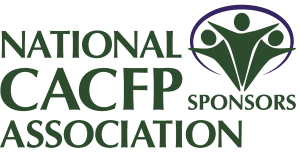







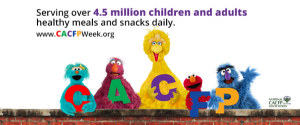







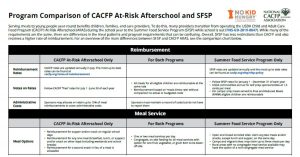

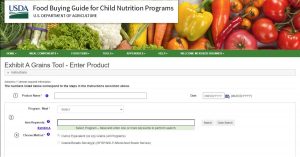
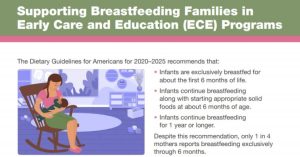





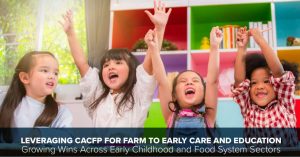








NCA Response – Proposed Rule for the Serious Deficiency Process
In February 2024, USDA released the proposed rule Serious Deficiency Process in the CACFP and SFSP. After meeting with members and extensive research NCA has submitted our response to USDA stating our position on the proposed changes.
Read More